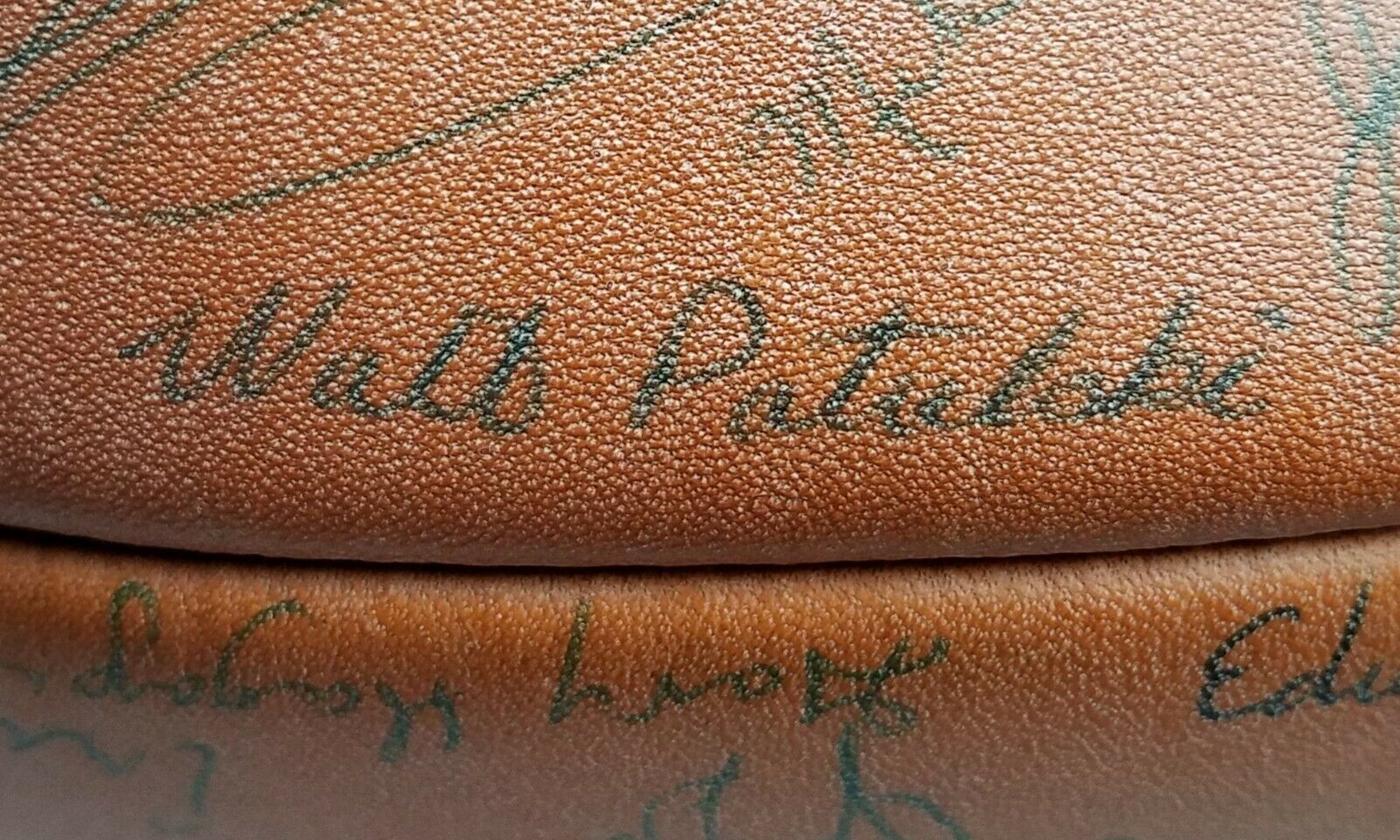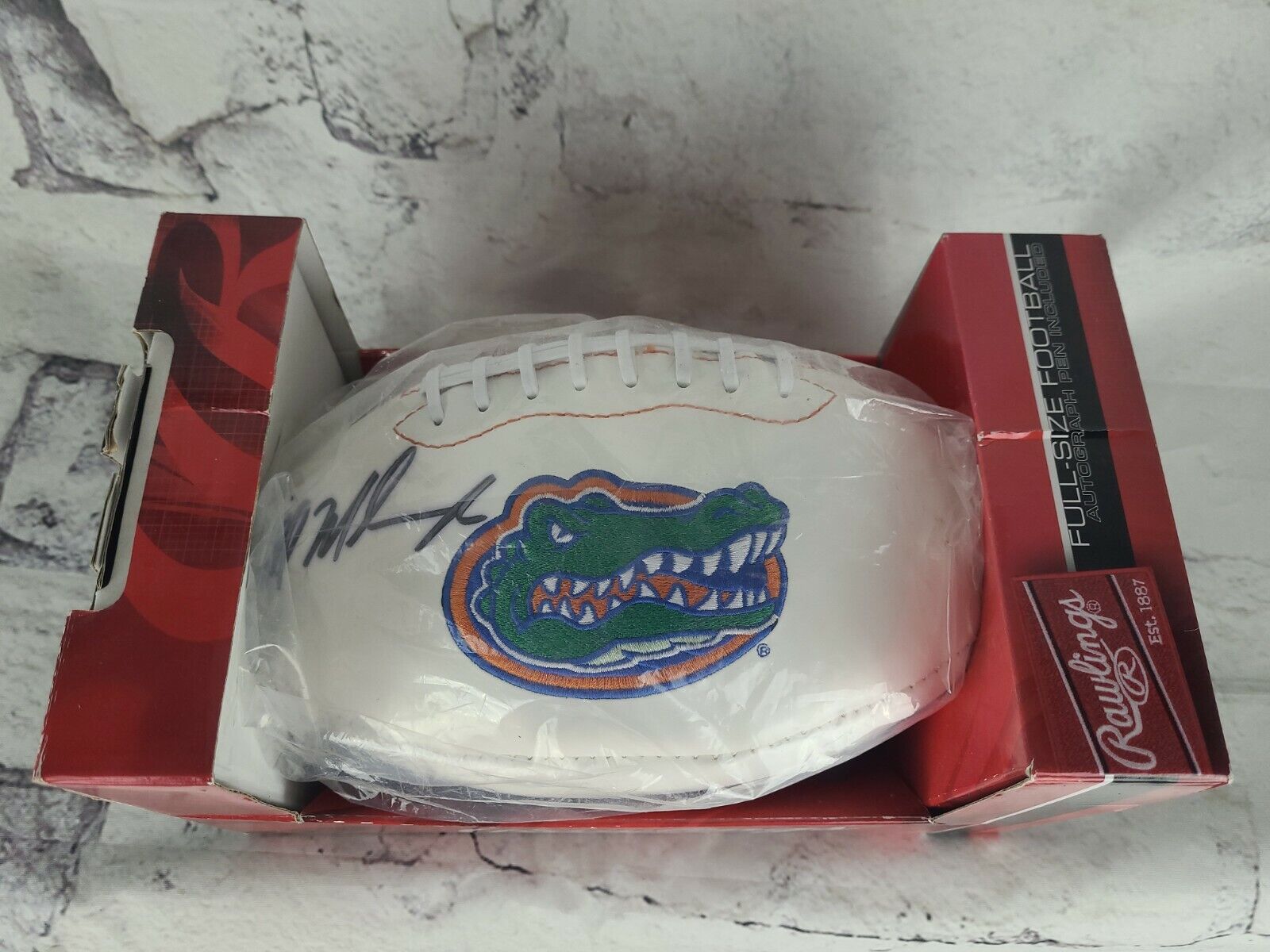-40%
1970 Notre Dame Fighting Irish Team Signed Football Joe Theismann Ara Parseghian
$ 224.4
- Description
- Size Guide
Description
1970 Notre Dame Fighting Irish Team Signed Football Joe Theismann Ara ParseghianAn original Notre Dame Fighting Irish Team Signed Football from the 1970 (10-1) Season
The Season Culminated in a 24-11 Win Over The "Unbeatable" University Of Texas Longhorns in the Cotton Bowl Classic
Signed by Head Coach Ara Parseghian; Quarterback Joe Theismann; Defensive End Walt Patulski; Team Co-Captains Larry DiNardo and Tim Kelly; Wide Receiver
Thom Gatewood; Defensive Back Clarence Ellis
and the majority (if not all) of the balance of the 1970 Fighting Irish team
Signatures are on a regulation size Sonnett Presentation football
In very good vintage condition; highly legible signatures with some fading
Shallow "dent" as shown in photos - Reinflation not attempted
Stand in photos is not included
PRIDE AND RESILIENCY FUELED 1970 NOTRE DAME FOOTBALL TEAM
By Todd Burlage (Sept. 4, 2015)
When University of Notre Dame legend Walt Patulski revisits the countless highs and one unbearable low of the memorable 1970 football season, he’s overcome with equal parts pride and punishment.
The pride comes from recollections of an Irish team that started the year 9-0 and finished the season by beating the unbeatable Texas Longhorns in the Cotton Bowl.
The punishment comes from the unthinkable upset loss to an average USC team in the regular season finale that cost Notre Dame a national championship.
“We just got caught by USC when we weren’t 100 percent, and that was really disappointing,” says Patulski, a star defensive end on that Fighting Irish team.
Time has allowed Patulski’s disappointment to fade some, and his pride to swell. And his satisfaction is plenty evident this weekend as one of approximately 60-plus members of the 1970 team reunites on campus to be honored by the University on the 45-year anniversary of a magical and memorable season.
The Irish finished that year 10-1 and No. 2 in the country behind national champion Nebraska, one spot shy of the ultimate goal, but a season still worthy of the recognition and celebration being shared this weekend.
“I just happened to be looking at the national championship aspects of that season and I had forgotten how close we were to winning one,” Irish icon Ara Parseghian, the architect and head coach of the squad, recalls.
This wasn’t one of the 11 consensus national title winners at Notre Dame, two coming under Parseghian. But similarly to the 1948, 1953, 1964, 1989 and 1993 teams that were a play or two away from a title, this 1970 team still rates as one of the best in Notre Dame lore.
Offensively Speaking
In an era when a ball-control, power-running game was the strategy of choice, this Notre Dame team broke the mold with what remains the highest-octane offense in program history.
Led by legendary quarterback Joe Theismann, star wide receiver Thom Gatewood, a balanced stable of overachieving running backs, and the most balanced Irish offense in school history, this 1970 squad still holds the single-season school record with 510.5 yards per game, highlighted by 257.8 rushing yards and 252.7 passing yards per outing.
“It was a versatile team, very difficult to defend,” Parseghian says.
The only other Notre Dame offense ever to average at least 200 yards rushing and 200 passing was the 1977 national champions (231.9 rushing and 208.1 passing). That squad featured a group loaded with National Football League offensive prospects, including future first-round picks in running back Vagas Ferguson, tight end Ken MacAfee and offensive tackle Tim Foley, all being led by a pretty good third-round quarterback named Joe Montana.
For contrast sake, the 1970 offense was built more on coordination and cohesion than it was star power, even though it remains one of only two offenses in Notre Dame history (1968) to average more than 500 yards a game.
Not one of the starting offensive linemen from the 1970 team ever played in the NFL, and none of its top five running backs was drafted to the NFL, a draft that featured 17 rounds and 442 picks back then.
In fact, a walk-on halfback, Ed Gulyas, led the Irish with 534 rushing yards that season.
“If you had the A- and B-team players lined up on the field, most of us were B-team players that played like an A-team when we got together,” says Irish linebacker Tim Kelly, who along with offensive lineman Larry DiNardo co-captained this group 45 years ago.
Make no mistake, the 1970 team was not without its share of great players. Theismann, Gatewood, DiNardo and defensive back Clarence Ellis were all first-team all-Americans that year, and Patulski became the No. 1 overall selection in the 1972 NFL Draft.
Yet, ask any of the former players about that season and they will point to coaching and chemistry as the primary reasons for a scoring offense that ranked No. 9 in the country at 33 points a game, a points production mark more recently that has only been reached once at Notre Dame since 1996.
“It was kind of a look-and-see season, and we just started gelling,” says Gatewood, the leading Irish receiver and favorite target of Theismann. “As the season went, it was a gradual process. The offense started picking up momentum, we really started to believe in ourselves. There was terrific leadership from the coaching staff, giving us great game plans, great scouting reports and great confidence.”
Having a quarterback named Theismann didn’t hurt production either.
Theismann’s 2,429 passing yards in 1970 remained the single-season school record for 29 years, helping to make him the Heisman Trophy runner-up to Stanford quarterback Jim Plunkett. And with 406 rushing yards that season, Theismann also became the first Irish quarterback to rush for more than 1,000 yards in a career.
“I was confident in our quarterback but I wasn’t sure what to expect from the team in the early going,” Parseghian says. “Before the season started, I knew that we had some spots that didn’t look very good and there were some areas of depth concern. But as the season progressed, this group came together as well as any I’ve coached.”
Defensively Speaking
During the 9-0 start, the Irish defense surrendered only 59 points total, or 6.6 a game, while never allowing more than 14 points in any of those nine contests. After losing three consecutive games to rival Purdue and going winless in nine straight trips to Michigan State, Notre Dame pitched shutouts in back-to-back weeks versus the Boilermakers (48-0) and at the Spartans (29-0).
But the truest measure to the quality of the Irish defense came in consecutive November slugfests against Georgia Tech, a team that finished No. 13 in the final Associated Press Poll that season, and SEC champion LSU.
Notre Dame allowed the Yellow Jackets only 141 yards in a 10-7 Irish win and then held the Tigers to just 165 total yards in an epic 3-0 victory to run its record to 9-0 that set up the regular-season finale at USC with national championship hopes still very much alive.
“The defense was able to kind of step up when the offense stalled and hold the scores down, so we were always in the game,” Patulski says. “There was a lot of balance between our offense and defense, it really wasn’t one-sided either way. I think that is another characteristic of that team.”
Gatewood is also quick to celebrate the Irish defense for making the Notre Dame offense much better.
“The defense was shutting people down,” he says, “giving the offense a chance to be on the field a lot, to really perfect the plays and put a cohesive team on the field.”
In all, eight defensive regulars from the the junior and senior classes of the 1970 team – and 13 players total – were drafted into the NFL.
Lowest To Highest
With four losses in its previous six games and a disappointing 5-4-1 record, USC wasn’t given much of a chance in the regular season finale against the undefeated Irish.
“That USC team was not one of the best USC teams we ever faced,” Gatewood says.
Bowl invitations during this era were extended before the regular season ended, and prior to the USC game, Notre Dame already hadaccepted a bid to play in the Cotton Bowl against top-ranked Texas – the reigning national champions and a team that hadn’t lost since early in the 1968 campaign.
But eight giveaways to the Trojans, including two lost Irish fumbles deep in their own territory, led to a 38-28 Notre Dame defeat to USC in Los Angeles, negating a school-record 526 passing yards from Theismann and dashing any realistic hopes that the Cotton Bowl would be played for the national title.
“That was an example of we just beat ourselves,” Gatewood says of the loss. “They just caught us off guard. We were certainly disappointed.”
Down but not out, Parseghian rallied his troops, went to Dallas about a month later, and pulled one of the greatest upsets in college football history, recovering five of nine Texas fumbles to break the Longhorns’ 30-game winning streak in a convincing 24-11 Cotton Bowl win.Notre Dame coaches and players alike still marvel at the team’s ability to rebound from one of the program’s toughest losses to one of its greatest wins.
“I remember vividly the joyousness in the locker room after the game, everybody jumping up and down, and all of a sudden going around in a circle,” says Parseghian, now 92 years old. “That was very invigorating to all involved with our team, a very memorable occasion.”
With Texas disposed and only one loss, No. 6 Notre Dame still held slim title hopes if the dominoes fell and the stars aligned, and they did.
Later that afternoon, No. 2 Ohio State was upset by Stanford in the Rose Bowl, meaning if No. 3 Nebraska lost to LSU in the Orange Bowl, the Irish would likely be No. 1. LSU led 12-10 in the fourth quarter but a late touchdown drive capped a 17-12 win for the Cornhuskers and sent the title trophy to undefeated Nebraska, leaving Notre Dame at No. 2, a painful yet satisfying ending to one of the best seasons in Irish history.
“Enthusiastic, resilient, talented, a lot of energy, great leadership: That’s how I would define this team,” Parseghian says. “We didn’t belong to a conference so a national championship is what you are shooting for. We came close on a number of occasions, and that year we came very, very close!”




















